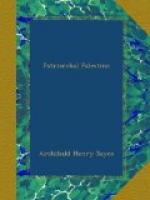The term “Palestine” then is used geographically without any reference to its historical origin. It denotes the country which is known as Canaan in the Old Testament, which was promised to Abraham and conquered by his descendants. It is the land in which David ruled and in which Christ was born, where the prophets prepared the way for the Gospel and the Christian Church was founded.
Shut in between the Desert of Arabia and the Mediterranean Sea on the east and west, it is a narrow strip of territory, for the most part mountainous, rugged, and barren. Northward the Lebanon and Anti-Lebanon come to meet it from Syria, the Anti-Lebanon culminating in the lofty peaks and precipitous ravines of Mount Hermon (9383 feet above the level of the sea), while Lebanon runs southward till it juts out into the sea in its sacred headland of Carmel. The fertile plain of Esdraelon or Megiddo separates the mountains of the north from those of the south. These last form a broken plateau between the Jordan and the Dead Sea on the one side and the Plain of Sharon and the sea-coast of the Philistines on the other, until they finally slope away into the arid desert of the south. Here, on the borders of the wilderness, was Beersheba the southern limit of the land in the days of the monarchy, Dan, its northern limit, lying far away to the north at the foot of Hermon, and not far from the sources of the Jordan.
Granite and gneiss, overlaid with hard dark sandstone and masses of secondary limestone, form as it were the skeleton of the country. Here and there, at Carmel and Gerizim, patches of the tertiary nummulite of Egypt make their appearance, and in the plains of Megiddo and the coast, as well as in the “Ghor” or valley of the Jordan, there is rich alluvial soil. But elsewhere all is barren or nearly so, cultivation being possible only by terracing the cliffs, and bringing the soil up to them from the plains below with slow and painful labour. It has often been said that Palestine was more widely cultivated in ancient times than it is to-day. But if so, this was only because a larger area of the cultivable ground was tilled. The plains of the coast, which are now given over to malaria and Beduin thieves, were doubtless thickly populated and well sown. But of ground actually fit for cultivation there could not have been a larger amount than there is at present.




